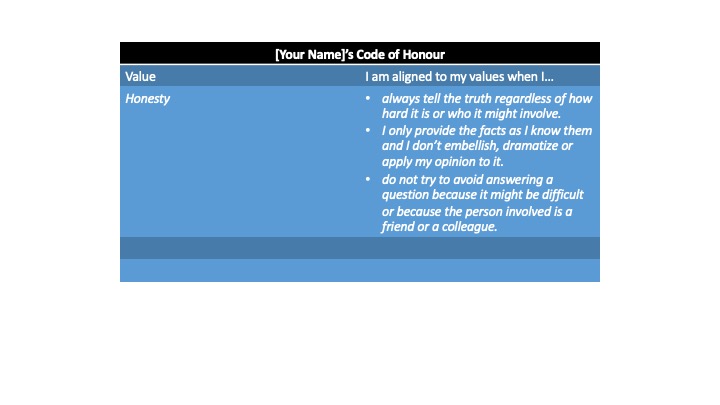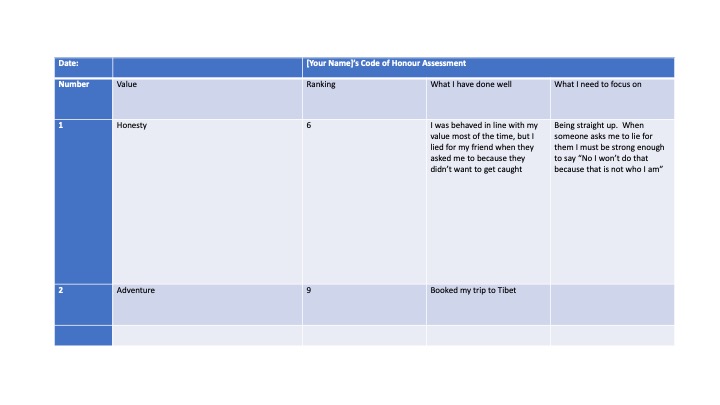
How about we work through these 7 steps to identify our personal values and at the end I will talk about an exercise I use to “check in on myself” that you might find useful.
There are many ways and methods to identify your values so if this approach doesn’t work for you then you should do some further researching to find a method that does. In the end, it is not so much how you identify your values, but that you do it.
Setting the scene
This is not a process of just googling a list of values and picking a few that “seem” right. It is truly a process of self-discovery and it will take some time. To get the best results clear some space to work, cultivate an open and curious mindset and give yourself up to the exploration.
Step 1 – Take a look at your upbringing
Start by exploring the behaviours and messages you were exposed to by your immediate family while you were growing up. If you think about a new born child they arrived with a “baseline program” if you like which is designed to ensure their survival. But other than that, they are open vessels whose first interpretations of the world are going to be informed by their parents and their siblings.
So, your first step is to identify those behaviours and messages you gained from those early interactions and experiences and make a note of them. Use as many words as you need to. Don’t think that at this stage you must just have a single word to explain such complex concepts. This is simply a brain dump exercise so don’t limit yourself.
When I did this some of the things I came up with were:
- Hardworking / can do / motivated / get on with it
- Giving / tender / loving / warm
- Strict / disciplined / no excuses / take responsibility / own it
- Be honest / true to your word / lying means punishment
Take some time and think about what you experienced and jot them down.
Step 2 – When you get it right and when you get it “not so right”
Great work. Now we are going to delve a bit deeper. In this next step, I want you to think about each of the following situations and take note of your responses:
- Think about a time when you were really on song, in the flow, everything felt great and it seemed that you couldn’t do anything wrong. What was happening to you? What was going on for you? What ideals, that you hold as being important, where you honouring at the time?
- Next, go in the other direction. Think about a time when you were really upset, frustrated, aggravated with yourself. What was happening to you? What was going on for you? What ideals, that you hold as being important, where you not honouring at the time?
For example, you might recall a time when your best friend was in a really tough spot and they reached out to you for help. You immediately dropped everything you were doing, went to them and helped them out of the terrible situation. When you analyse this, you might decide that the ideals you were honouring for yourself in doing this included loyalty; being a good friend; caring; taking action; going the extra mile; being of service.
Equally, using the same situation it might have been a case when you put your friend off and left them in that situation. Afterwards you felt angry with yourself, out of sorts with yourself, frustrated. Ask yourself “what ideals, that I hold as important to me, didn’t I honour in that situation?”
By the way, you will get the same list – loyalty; being a good friend; caring; taking action; going the extra mile; being of service.
As a note it is sometimes easier to start with the time when we didn’t “get it right” because these emotions are often so strong and so leave a lasting impression on us.
Step 3 – One more step down the rabbit hole
Time to take one more step down the rabbit hole. Beyond your basic needs, what do you have to have in your life to feel fulfilled?

To answer this question we need to understand a bit about what fulfilment is. In his 1998 book titled “Self-Fulfilment” Alan Gerwith defines fulfilment as:
- “carrying to fruition one’s deepest desires or one’s worthiest capacities”.
- He then goes on to say that fulfilment is “the attainment of a satisfying and worthwhile life well lived”.
- Finally, he states “it is the bringing of oneself to flourishing completion, an unfolding of what is strongest or best in oneself, so that it represents the successful culmination of one’s potential. In this way self-fulfilment betokens a life well lived, a life that is deeply satisfying, fruitful and worthwhile.”
Your task in this step is to identify those things that you need in your life to achieve fulfilment. It might be to adventure in wild places, to always be there for your family, to give back to your community. Don’t limit yourself here, write as much as comes to mind and remember this is just for you so be brave and be honest with yourself, there is no right or wrong answer.
Step 4 – Grouping common themes
Okay we now get a break from the deep work and self-reflection. With your list in front of you go through and group what you have written down into common themes. Things like don’t lie, honesty, telling the truth, owning up are all dealing with a similar theme. Things like learning, curiosity, education, growth, experiences are all dealing with something similar.
If you find yourself wanting to put an item into more than one group then stop for a minute and consider why. It is likely that you have used a word or group of words to capture more than one concept or ideal. If this is the case then rewrite it so that you have two or more clearly separate ideals and then apply them to your groupings individually.
Step 5 – Find the keyword that resonates for you for each group/theme
Next look at the words in each grouping and identify a key word that best describes the theme of the group for you – it resonates with you. Looking at our previous example of don’t lie, honesty, telling the truth, owning up – then you might decide that honesty is the key word for this grouping that most resonates with you; feels most you.
If you want to explore other key words for values then there are many sites available on the web that provides lists of values for you to look at. Simply search for “personal values”. Or you can download a free list I have created that provides a theme and a brief explanation of the theme to help you select the correct one here.
Yes. Please send me the Personal Values Table
Or use a combination of both ideas. This is about you accessing all the information you need to make your decisions.
Step 6 – Prioritising your list
Once you have your key words, which by the way are your values so well done, you may still have a sizable list. It is now a good idea to prioritise them so we can start to whittle them down to your absolute must haves. We all have many values, however we all find that some will take precedent over others every time. Identifying these top three to six will help you understand why sometimes you feel aligned and settled with yourself (“in flow”) and sometimes you don’t.
To do this prioritising piece “Bubble Sorting” is a good process to apply. It is the process of comparing the importance of one item on your list to every other item on your list. Watch this video to get an understanding of the principle behind bubble sorting.
Okay, now that you know the concept let’s use it to prioritise our values, bearing in mind that the question you will be asking yourself as you go through the sort process is:
“of the 2 values I am looking at, which is more important to me?”
- Write out your values on some sticky notes or pieces of paper – one value per note.
- Lay them out in a row next to each other.
- Then go through the bubble sort process as many times as you need to get your prioritised list.
What you should have at the end of the process is your values ranked from most important on the left to least important on the right.
With your values sorted you now simply need to review those that have positioned 6th, 7th 8th and so on and ask yourself “if I am living by my top 5 values, will I also then be living by this value?”. If you answer yes then you can remove this from your list, If the answer is no then you absolutely need to keep it in your list.
Step 7 – Identify the specific behaviours that support your values
The last step is to identify the behaviours that will demonstrate to you when you are acting in alignment with your values. This will become your personal code of honour.
Create a document that looks like the following:

List your most important value on the left-hand side and then in the right hand column describe the behaviours, that for you, demonstrate you are honouring that value.
Aim for 3 behaviours per value.
If you find it difficult to identify the behaviours, then ask yourself this. What would I be doing if I wasn’t acting in alignment with my value and then simply put a “I will not…” in front of that. For example, rather than writing always tell the truth… you would write “I will not lie…”. Just a as a note, most of us find it easier to do this part of the process in this manner.
Right here, right now you have your personal values – awesome!!

Getting your Baseline – Identifying your current alignment to your personal values
Now that you are really clear on your personal values it is worth taking a moment to identify just how satisfied you are with your alignment to your values right now, so let’s go ahead and get a baseline.
- Set up a table like the one below.
- Review the behaviours you have listed against each value.
- Think about the last 3 months and rank how satisfied you are with yourself against each value from 1 to 10 with 10 representing that you have absolutely nailed it and 1 meaning you are super disappointed with yourself.

Anything that you scored 7 and lower are areas you need to highlight for future work because you are not in alignment with your values and therefore you are not living your thriving life.
Conclusion
This baseline check in is a good exercise to do once a month or once every 3 months as part of your general reflections and gratitude practice. It provides an opportunity to check in with yourself, hold yourself accountable for your actions, identify where you have smashed it out of the park and identify those areas that you need to focus on in the coming months.
Remember to celebrate those moments when you have smashed it because in doing so you have acted with integrity and been true to the essence of who you are – so inspiring. Equally, don’t hammer yourself for not getting something right, we are all a work in progress and you know what, we all get shit wrong. What you are doing her is having the courage to identify when you were not “in flow” and taking steps to correct it – that is equally inspiring.
I personally do this process once every month to “check in with myself” and to realign myself to my “true self”.
Remember, we are on a journey of growth and discovery together here and we don’t have all the answers so we will absolutely go astray at times and that is okay (within reason of course). Including this exercise, as part of regular reflection, will always ensure you are moving forward aligned to your values and your personal framework of commitment or personal code of honour. How bloody awesome is that!! And what would the world look like if we all were doing the same thing.
In the next post we will work through a practical exercise to identify our purpose.
This is the third part in this series. If you would like to know more about what a Life Purpose is and why we should have one, please read my previous posts.
Available below is a link to an eBook on this series.
Take care and talk soon.
Thrive; don’t just Survive with Janette
